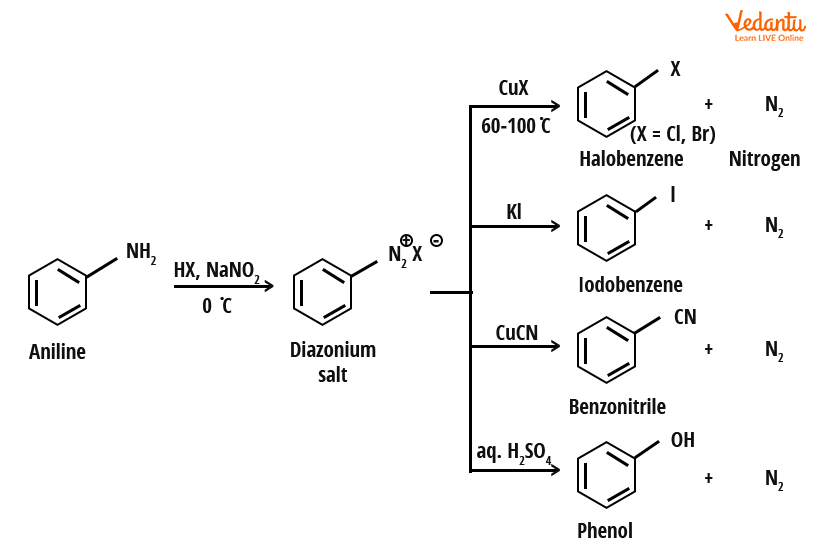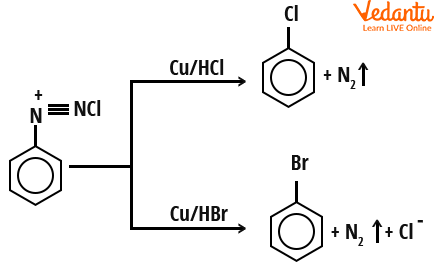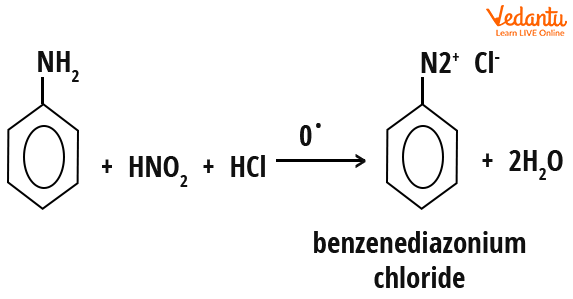




Introduction to Preparation of Haloarene
Unlike haloalkane, which can be made from alcohol, haloarene cannot be made from alcohol. Because the –OH group of phenol cannot be easily substituted due to resonance, the C–O bond in phenols has a partial double bond character and is thus stronger and more difficult to leave. As a consequence, phenols cannot be converted into haloarenes. But there are several ways to make haloarene, including diazonium salts, Sandmeyer's reaction, and Gattermann's reaction. We will discuss Sandmeyer's reaction and Gattermann's reaction in-depth in this article.
Sandmeyer’s Reaction
What is Sandmeyer's Reaction? A type of substitution reaction. Sandmeyers reaction is used to prepare aryl halides from aryl diazonium salts. Copper salts like chloride, bromide, or iodide ions are used as catalysts in Sandmeyer's reaction. Diazonium salts are highly reactive compounds that are used in the synthesis of arene derivatives. When diazonium salt is treated with copper (I) chloride (Cu2Cl2) or copper (I) bromide (Cu2Br2), the corresponding haloarene is formed. This is referred to as the Sandmeyer reaction. Sandmeyer reaction is used to prepare haloarenes.

Example of Sandmeyer Reaction
Mechanism of Sandmeyer’s Reaction
A free radical mechanism governs the Sandmeyer reaction. The production of diazonium salts and the transformation of diazo intermediates into aryl halides are two steps in the synthesis of aryl halides from primary aryl amines (i.e., displacement with a nucleophile).
Step 1: Nitrosonium ion formation: Protonation occurs twice, with sodium nitrite reacting with hydrogen halide to form nitrosonium and halide ions.

Formation of Nitrosonium Ion
Step 2: Formation of benzene diazonium ion: The electrophilic nitrosonium converts an amine into a diazonium salt.

Formation of Benzene Diazonium Ion
Step 3: A single electron transfer from the copper to diazonium and from halide to copper (I) halide ion results in the formation of a neutral diazo radical and copper (II) halide.

Transfer of an Electron from Copper to Diazonium
Step 4: The diazo radical releases nitrogen gas to form an aryl radical, which reacts with the copper (II) halide to regenerate the copper (I) halide catalyst and form the final aryl halide product.

Formation of Aryl Halide
Gattermann’s Reaction
The Gattermann reaction method is almost similar to the Sandmeyer reaction. It is a formulation method for aromatic ring compounds. The Friedel-Crafts reaction is also similar to the Gattermann reaction. By treating benzene diazonium chloride with Cu/HCl or Cu/HBr, the Gattermann reaction is used to obtain chlorobenzene or bromobenzene. Aromatic diazonium salts are typically made by adding a cold aqueous solution of sodium nitrite to a solution or suspension of a primary aromatic amine in acid at a temperature of 273-278 K.

Example of Gattermann’s Reaction
Preparation of Diazonium Salt
Diazotization is the process of converting a primary aromatic amine into its diazonium salt. Let us discuss the process for the formation of diazonium salts. The primary aromatic amine is dissolved or suspended in a dilute acid like HCL, H2SO4 and so on. (In general, three moles of acid are used for every mole of amine to be diazotized; one mole to form the amine salt, one mole to liberate nitrous acid from sodium nitrite, and one mole to keep the reaction mixture acidic enough to suppress undesirable side reactions such as coupling of the diazonium salt thus formed with the free amine.)
The amine solution is cooled, and a cold aqueous solution of sodium nitrite is slowly added to it at such a rate that the reaction mixture's temperature does not rise above 278 K. When a few drops of the reaction mixture produce a blue colour with starch-potassium iodide paper, indicating the presence of unreacted nitrous acid in the reaction mixture, the addition of sodium nitrite solution is stopped. Excess nitrous acid is generally avoided because it interferes with the reactions of diazonium salts. The excess nitrous acid can be destroyed by adding urea.

Preparation of Diazonium Salt
Conclusion
Haloarene cannot be produced using alcohol, in contrast to haloalkane, which can. Phenols are not capable of being transformed into haloarenes. However, there are numerous processes for producing haloarene, including Gattermann's reaction, Sandmeyer's reaction, and diazonium salts. Aryl diazonium salts are converted into aryl halides using the Sandmeyers reaction. In Sandmeyer's reaction, catalysts such as chloride, bromide, or iodide ions are utilised to speed up the process. The Gattermann reaction method and the Sandmeyer reaction are essentially identical. The Gatterman reaction is a technique for creating compounds with aromatic rings. It is possible to produce chlorobenzene or bromobenzene via the Gattermann reaction by reacting benzene diazonium chloride with Cu/HCl or Cu/HBr.
FAQs on Preparation of Haloarene for JEE
1. Write properties of diazonium salts.
Arenediazonium or diazonium salts are colourless crystalline solids that are highly soluble in water. Many diazonium salts, particularly nitrates, are explosive in the dry state. As a result, they are never isolated but rather prepared in situ and used immediately after preparation. Certain diazonium salts, such as fluoroborates, are relatively insoluble in water and can be dried and stored. Some diazonium salts form complexes with metallic salts like zinc chloride, for example, (ArN) and ZnCI. In general, these complexes are insoluble.
2. What is Haloarenes?
Haloarenes are aromatic hydrocarbon halogen derivatives in which the halogen atom is directly linked to an aromatic ring carbon atom. They are also known as aryl halides. Haloarenes are created when a halogen atom replaces a hydrogen atom linked to an aromatic ring. The haloarene is represented by Ar–X, where Ar represents an aryl group and X is a halogen atom. The carbon in the aromatic ring and the halogen attached determine the nature of the C-X bond. Halogens are more electronegative than carbon, the C-X bond in haloarenes is polarised.
3. Why does haloarene not undergo nucleophilic substitution reaction in comparison with haloalkane?
A C—X bond exists in both haloalkanes (alkyl halides) and haloarenes (aryl halides). Out haloarenes and vinyl halides are far less reactive to nucleophilic substitution reactions than haloalkanes. The low reactivity of aryl and vinyl halides can be explained by the resonance. In the resonance effect, the lone pairs of electrons on the halogen atom are delocalized on the benzene ring in haloarenes (e.g., chlorobenzene). As a result, the C-Cl bond takes on some double bond characteristics. But in the case of alkyl halides (for example, methyl chloride), carbon is joined to chlorine by a single bond. As a result, the C-X bond in aryl halides is slightly stronger than in alkyl halides and thus cannot be easily broken. Another reason for aryl halides' lower reactivity compared to alkyl halides is their less polar character.










